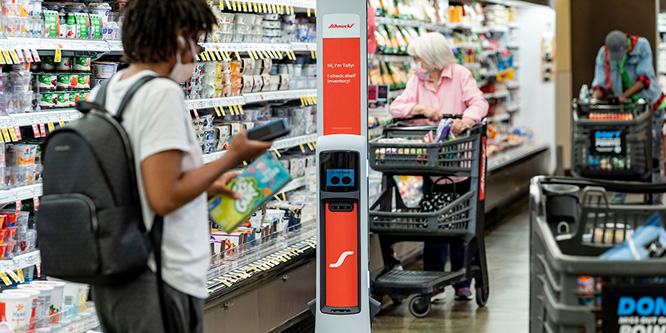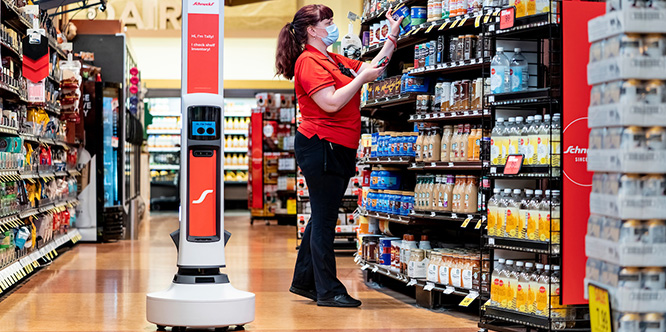
Photo: Simbe Robotics; Schnucks
August 27, 2021
Are robots taking over Schnucks’ stores?
Schnuck Markets is going to the robots. The family-owned grocery chain announced that it is rolling out artificial intelligence-powered robots to all 111 of its stores in Illinois, Indiana, Missouri and Wisconsin.
The robots, known as Tally, are part of a multiyear program that began as a six-week pilot in 2017 at three stores and was expanded in 2018 and again last year. The devices move up and down store aisles up to three times a day to identify where there are stock outs as well as scanning shelves to make sure that each item is in its proper place and aligned with the correct shelf tag.
A joint press release by Schnucks and Simbe Robotics, its technology partner, claims that the chain is the first grocer in the world to “utilize AI-powered inventory management technology at scale.”
The companies claim that the robots have enabled Schnucks to identify 14-times more out-of-stocks than manual scans by human associates and reduced stock outs between 20 and 30 percent, depending on the store. Increased accuracy of shelf stock has improved the grocer’s real-time inventory management and the process has been integrated into its automated replenishment system.

Dave Steck, vice president of IT infrastructure and application development, Schnucks, said his company and other grocers “are facing a ‘new normal’” and that the robots deployed have “been instrumental to ensuring we continue to provide an exceptional store experience while rising to meet new operational challenges.”
Mr. Steck said that with the rollout of the robots, Schnucks will be “fully operationalizing these insights into our supply chain and expanding our ability to leverage real-time data to make revenue impacting decisions.”
The robots, he said, have “become an integral component of our stores, streamlining operations and ultimately creating a better store experience for our customers and teammates.” The devices, based on a video posted to Schnucks’ Facebook page, appear to not be a problem for Schnucks’ customers and may actually be a source of fascination for some.
Schnucks’ decision to roll out its inventory-taking robots stands in contrast to Walmart, which announced last year that it was discontinuing its use of similar devices after determining that they could be replaced at a lower cost by human associates. Walmart said that the associates, as they fill online orders for pickup and delivery, are better able to draw attention more quickly to low inventory and out-of-stocks than robots.
Discussion Questions
DISCUSSION QUESTIONS: What is your reaction to Schnuck Markets decision to deploy its inventory-taking robots chainwide? Do you think more retailers selling fast-moving goods will take the approach of Schnucks or Walmart when it comes to this type of technology going forward?
Poll
BrainTrust
Trevor Sumner
Head of AI and Innovation, Raydiant
Recent Discussions







I think it’s a financial decision. If the robots are able to do this job more efficiently and effectively than people, put the people into other functions where their skills can flourish. And don’t believe the stuff about real-time data – he’s been reading a sales brochure. The value comes in fewer out-of-stocks making for a better shopping experience.
Inaccurate inventory and out-of-stocks are a huge problem for grocers and anything that dramatically improves these issues is a big win. The Tally robots are sleek and don’t look like they would interfere much with shoppers. Some robots also multitask and clean floors while they are scanning shelves for inventory. While most robot use cases are for backroom or warehouse environments, the current labor shortages are causing retailers to test new uses for robots on the sales floor.
I’ve worked with retailers who piloted robots in-store and primarily the feedback was that the solutions are less than optimal. That’s because the data is stale the moment the bot moves on to the next aisle, they can sometimes frustrate shopping customers, and the maintenance of hardware can be a chore. The ROI is challenging when it’s a one-trick pony too. That’s why some stores opted for bots that can serve multiple purposes, like also cleaning floors, monitoring for spills or other safety hazards, and providing screens for automated customer service like item location or self checkout.
That said, most retailers are looking to utilize existing assets and investments with enhancements to existing technology. For example, existing loss prevention cameras may be used to spot voids on the shelf and confirm planogram compliance using custom vision and AI. Those sorts of solutions don’t require a lot of new h/w to install or maintain and the near real time updates from an existing fleet of AP/LP cameras already scanning the store can see spills and out-of-stocks instantly. Hazards and shelf issues that a robot would miss as it turns the corner.
100 percent agree. The future is better dome camera usage or cameras at the shelf with real-time data.
Real-time inventory is the single most important factor in delivering a great omnichannel customer experience. By continuously updating inventory data in their stores, Schnuck Markets can better manage their delivery and curbside services, which will ultimately improve customer loyalty and repeat business. Go robots!
We all know that out-o- stocks is a historical pain point for nearly all retailers and if Schnucks has found a robot that can drive down these incidents while not degrading the customer shopping experience, then more power to them. Many have tried and failed for one reason or another — to me, it’s a financial and experience decision. I personally like video combined with IoT sensors because these can be deployed at relatively lower cost than robots, are nearly invisible to the shoppers, and are data and analytically rich in a variety of ways.
According to a white paper by Trax, the out-of-stock (OOS) rate remains at a high 8 percent, and a study from IHL Group1 confirmed that OOS accounts for as much as 4.1 percent of lost revenue for the average retailer – with 50 percent caused by defective shelf execution practices. There is no question that the future requires better planogram enforcement and OOS detection. The question is how. Robots seem highly inefficient and costly to me. I think the future is computer vision either at the shelf, or through more powerful dome cameras. No need to interfere with shoppers, nor maintain and charge a fleet of robots. Robots seem like a short-term fix to me.
The ongoing out-of-stock problem needs to be solved by retailers. Robots is one method; using store associates who pick orders is another. Ultimately we may get to a “smart shelf” environment that will track inventory level. If Schnucks’ decision makes sense for the company then I applaud its willingness to break new ground in seeking to solve a long-time challenge.
In today’s world of disrupted supply chains, demand variability, rising purpose-led smaller brands, and declining brand loyalty, CPG manufacturers and retailers are aligned so that customer experience and on-shelf availability are key to growth, much more so than they were ever before. It makes total sense to automate that task. How much money should be invested is subjective because it depends upon how the benefit is measured really. Are there better ways to track than using bulky, expensive robots? Sure, I think the market will emerge from here.
Inventory optimization, replenishment, and dynamic forecasting are required to meet the needs of the dynamic and supply chain-constrained grocery industry. Leveraging robotics is a natural evolution of that process to drive efficiencies, profitability and remove some of the dependencies on the store associates to lead the replenishment processes.
The most significant challenge for grocers has been the pandemic-fueled supply chain constraints and challenges in getting products on the shelves in a timely manner. Robotics is a long-term strategy to become more predictive and precise with the demand and replenishment forecasting strategies.
Out-of-stocks cost money and so does human labor. If technology can provide a more cost efficient solution at the same time it improves the shopping experience I say bring on the robots and let the humans do what humans do best – interact with each other. I’ve said for much longer than I like to admit that technology is not a strategy. It is, at best, a tool for facilitating strategy. Robots will continue to be deployed until they are replaced by a better technological solution. If that solution doesn’t come along we will see lots of robots at retail. I think it’s also important to remember that AI/ML driven systems learn, sometimes faster than we do. So I wouldn’t judge the future of robotics solely on the limitations of the present.
Yes, AI-powered robots can do a fine job by replacing humans for assessing out-of-stocks and messed up planograms. But a few observations:
Good luck, Schnuck Markets.